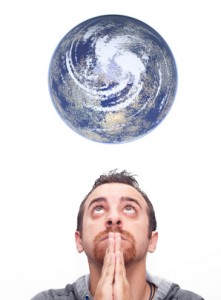Jonathan Morgan
 I began the series on religious statistics by asking the question: is religion disappearing? Okay, I didn’t ask it that explicitly, but it’s the question at the heart of secularization. And the question keeps intriguing me because it’s so difficult to answer. In America alone there are increasing numbers of religiously unaffiliated, but among those ranks, religion is still described as important to their daily lives. How do we explain that? Worldwide, the picture becomes even more complex.
I began the series on religious statistics by asking the question: is religion disappearing? Okay, I didn’t ask it that explicitly, but it’s the question at the heart of secularization. And the question keeps intriguing me because it’s so difficult to answer. In America alone there are increasing numbers of religiously unaffiliated, but among those ranks, religion is still described as important to their daily lives. How do we explain that? Worldwide, the picture becomes even more complex.
One of the most difficult things to figure out is why most industrial nations show a decline in religious affiliation, but worldwide the number of people holding strong religious beliefs is at an all time high. How do we juggle these seemingly opposed trends?
The World Values Survey is one of the few research groups attempting to explain both trends with one cause. Led by political scientists Ronald Inglehart and Chris Welzel, this team has tracked the changing values of nearly 87 nations from 1981 until now. The surveys include wide-ranging questions from political attitudes, to acceptance of homosexuality, to a variety of religious beliefs and practices. As you can imagine, this creates an enormous amount of data, capable of exploring a wide range of questions about cultural change.
Inglehart teamed up with Harvard’s Pippa Norris to try and discover what drives religious change worldwide. The result is a book, Sacred and Secular: Religion and Politics Worldwide, which is a substantial contribution to the secularization debate. Their theory challenges many previously held ideas about what causes religious change.
For example, many scholars follow the sociologist Max Weber, and argue that science and rational thought dispel religion within a culture. They point to the high levels of non-belief within scientific institutions as evidence for their theory. But Norris and Inglehart argue that this correlation can’t be causal.
The first argument against the Weberians is that rates of religious belief fluctuate too rapidly to be tied to rational thought. A generation’s educational level doesn’t change; once educated, people generally remain educated. But rates of religiosity change dramatically within a single generation. Furthermore, they found that a higher trust in scientific advance actually corresponds with higher rates of religious belief. The countries that are the most secular – the Netherlands, Norway, Belgium, and Denmark – are also the most skeptical of scientific progress.
Norris and Inglehart also challenge the Religious Marketplace theory, which argues that diversity and competition among religious groups promote overall religiosity (like the free market). This theory was put forward by sociologists Rodney Stark and Roger Finke to explain why the US has such high levels of religion compared to other, equally industrial, countries. To test this theory, Norris and Inglehart examined the relationship between religious pluralism and religiosity. They found no clear relationship when considered globally. This finding makes sense – the other most religious nations in industrial Europe are Italy and Ireland, both of which have a near religious monopoly with the Roman Catholic Church.
Instead of rationality or competition, Norris and Inglehart argue that existential security has the strongest relationship to a country’s religiosity. They define existential security as the feeling of assurance that survival can be taken for granted. This construct can be tracked by a variety of other measures: per capita GNP, access to clean water, number of doctors available, and rates of AIDS/HIV, to name a few. When people feel that their survival is not at risk, then religion diminishes in importance.
While “existential security” is a somewhat ambiguous construct, the authors reliably show its relationship to religiosity. For example, the high levels of religiosity in the US are explained, not by religious competition, but by the high economic inequality in the US (the highest among highly developed, industrialized, nations). This economic inequality undermines people’s existential security. Ireland is the second most religious nation in the West and also has the second highest level of inequality. This roughly linear relationship doesn’t prove their theory, but it does provide a much stronger correlation than Stark and Finke, or other secularization theories.
In further support of their theory, Norris and Inglehart predicted the emergence of “post-materialist” needs in highly secure nations. They are not arguing that religion will disappear; instead they argue that religious authority will diminish and new needs for meaning and purpose will emerge. It seems likely that the rise of New Age spiritualities in secular cultures may fulfill this prediction.
Even if you’re not too interested in the secularization debate, the World Values Survey offers a huge amount of other data, allowing many interesting relationships to be drawn. For example, researchers have recently used the data from the surveys to argue that belief in hell leads to lower crime rates and that religion discourages suicide. Whatever your interests, it’s a good bet that the World Values Survey has some data to support your ideas or challenge what you thought to be true.

Pingback: Statistics on Religion pt. V- Religion & Same-Sex Marriage | Exploring My Religion
I think that it depends on your region. Some regions religion is much more popular than others.